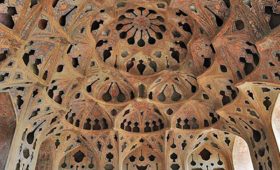The Sarhang Palace: A Glimpse into Isfahan’s Architectural Heritage
Isfahan, a city renowned for its historical landmarks and architectural wonders, offers a unique blend of Islamic, Persian, and Safavid architectural styles. Among its many magnificent structures, the Sarhang Palace stands out as a remarkable example of historical Persian architecture. Known for its intricate decorations and elegant design, the Sarhang Palace offers visitors a fascinating insight into the artistic and cultural heritage of Isfahan during the Safavid and Qajar periods.
Historical Background
The Sarhang Palace, located in Isfahan, was originally constructed during the Safavid period (1501–1736) and completed during the Qajar period (1789–1925). The palace was built for the military officers of the Safavid empire, with the term Sarhang referring to the title of “general” or “military commander” in Persian. As a residence for the military elite, the palace served both as a residential space and a place for administration, reflecting the importance of the military in Safavid society.
The construction of the palace began under the reign of Shah Abbas I, who is credited with transforming Isfahan into a grand capital city. The architecture of the Sarhang Palace embodies the elegance and luxury of the Safavid period, with its elevated ceilings, symmetrical design, and ornate decorations. Although it was initially built in the Safavid style, the palace saw significant changes and expansions during the Qajar period, which added further artistic and architectural layers to the structure.
Architectural Features of the Sarhang Palace
The Sarhang Palace is known for its intricate and diverse decorations, which distinguish it from other historical houses and palaces in Isfahan. The palace combines traditional Persian elements with innovations from the Qajar era, resulting in a unique fusion of architectural styles.
1. Courtyards and Gardens
Like many of Isfahan’s traditional houses, the Sarhang Palace is organized around a central courtyard. The layout follows the Persian garden tradition, with a central water feature and pathways leading to various rooms. The palace is surrounded by lush gardens, providing a tranquil and serene environment. The careful arrangement of trees, shrubs, and flower beds adds to the aesthetic appeal of the palace and creates a space for relaxation and reflection. The central courtyard, with its pools, fountains, and irrigation channels, provides a refreshing atmosphere, particularly in the hot summer months of Isfahan.
2. Decorative Elements
What truly sets the Sarhang Palace apart from other historic buildings in Isfahan is its elaborate decorations. The palace is adorned with intricate tilework, stucco designs, and calligraphy. The tiles are often in bright colors, such as blue, green, and yellow, featuring geometric patterns, floral motifs, and figures that reflect the artistic traditions of the Safavid and Qajar periods.
In addition to the tilework, the palace features decorative frescoes and paintings that depict royal scenes, mythological stories, and botanical motifs. The walls and ceilings are embellished with elegant plasterwork, highlighting the skilled craftsmanship of the Qajar artisans who contributed to the palace’s final appearance.
3. The Rooms and Interior Design
The Sarhang Palace is designed to include several large rooms, each serving a distinct purpose. The main hall is grand and open, used for official receptions, meetings, and entertainment. The hall is designed with high ceilings and large windows, allowing for plenty of natural light to fill the space. The room is adorned with colorful tilework and intricate wooden panels, creating an atmosphere of elegance and grandeur.
The private quarters of the palace are more intimate, with rooms designed for rest and family life. These rooms are decorated with Persian carpets, embroidered fabrics, and wooden furniture, all reflecting the comfort and luxury enjoyed by the palace’s residents.
The Qajar influence on the palace is particularly visible in the colorful frescoes that adorn the walls and ceilings. These frescoes often depict royal figures in Persian courtly settings and are painted in a vibrant and detailed style, showcasing the decorative tendencies of the Qajar period.
Cultural and Social Role of the Palace
The Sarhang Palace played an important role in the cultural and social life of Isfahan during the Safavid and Qajar periods. As a residence for the military elite, the palace was a symbol of prestige and power in Isfahan. The palace’s central location in the city made it a key site for military strategy and administrative functions.
In addition to its military role, the palace also functioned as a space for entertainment, gatherings, and diplomatic events. During the Safavid period, it was common for high-ranking officials, foreign dignitaries, and royal guests to be invited to the palace for ceremonial events. The palace’s elegant design and luxurious decor provided a fitting setting for these important occasions, reinforcing the wealth and status of the Safavid rulers.
Preservation and Modern-Day Significance
Today, the Sarhang Palace serves as an important historical site in Isfahan. The palace has been restored and maintained, and it continues to be a popular destination for visitors interested in exploring Isfahan’s historical architecture. The palace is now open to the public and offers a unique insight into the art, culture, and history of the Safavid and Qajar periods.
The Sarhang Palace is also a popular venue for cultural events, exhibitions, and traditional performances. It provides a space where visitors can experience Persian art and architecture while learning about the military and political history of Isfahan.
The Sarhang Palace is one of Isfahan’s most fascinating and historically significant landmarks. Its elegant design, intricate decorations, and rich history make it an essential part of the city’s cultural heritage. The Sarhang Palace stands as a testament to the artistic and architectural achievements of the Safavid and Qajar periods and continues to captivate visitors with its beauty and historical significance. Whether you’re interested in architecture, history, or simply want to explore a remarkable piece of Isfahan’s past, the Sarhang Palace offers a unique and enriching experience for anyone visiting the city.


